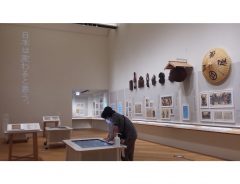- Tags:
- Kasai / metro / Museum / Subway / Tokyo Metro Museum
Related Article
-

Nostalgic Items and Stories: Special exhibition on the history of transportation in Yokohama
-

New Toilet Museum In Japan Shows Us The History Of Restrooms And…Urinals For Women And Toilet Bikes?! Look Inside Here.
-

Japanese illustrator’s “Real ‘Museum Girls’” series reinterprets classic paintings in SNS age
-

The Museum of Contemporary Art Tokyo
-

Japanese Bamboo Art Captivates Western Collectors and the World
-

How we became modern: a trip to Tokyo Advertising Museum



Now that the state of emergency has been lifted, Tokyo’s museums are once again welcoming visitors. The Tokyo Metro Museum offers a fascinating look at the history and science of the city’s subway system. There are more than 600 items on display in seven separate exhibit spaces, each displaying a different theme.
Photo by George Lloyd
The first section is dedicated to the history of the metro system and is full of interesting artefacts. The founding father of the Tokyo metro system was Noristugu Hayakawa. In 1914, he visited London and New York City to study their underground railways. Deeply impressed, he realised that a similar system would be indispensable if Tokyo were to become a truly modern city.
On his return, he began studying the soil and water under the surface of the city. His Tokyo Underground Railway Company faced opposition from sceptics, but eventually secured the backing of financiers. The first subway line in Japan – and Asia – opened on Dec 30, 1927. It ran between Ueno and Asakusa and was just 2.2 km long.
The first passengers were amazed by the turnstiles and the bright fluorescent lights in the carriages. It’s easy to imagine how they must have felt, for the museum has a beautifully restored Ginza line carriage from those days, complete with a family of dummies in period costume.
Photo by George Lloyd
Since then, the subway network has continued to expand massively, in step with urban growth. You can have a look around one of the first carriages to go into service on Tokyo’s second underground line, the Marunouchi Line, which opened in 1954.
Most of the subway lines that we take for granted today date from the 1960s or thereabouts when Japan was enjoying record-breaking economic growth rates. The Hibiya line opened in 1959, the Tozai line in 1962, the Chiyoda line in 1966, the Yurakucho line in 1970, and the Hanzomon line in 1973. You can see the pretty tickets that were issued to commemorate the opening of each of Tokyo’s subway lines.
Photo by George Lloyd
In other sections, you can learn how the subway was built, and wonder at the sheer size of the boring machines that were used to create tunnels under the city.
Photo by George Lloyd
There is a replica of the warren of tunnels, bridges and waterways at Ochanomizu that demonstrate just how complicated it must have been to build a railway network under a congested city like Tokyo.
Photo by George Lloyd
When tunnels are dug, interesting things often turn up. During construction work on the Marunouchi line near Ochanomizu, workers found wooden water pipes used to supply drinking water dating from the Edo period. They also found pottery dating back to the Jomon period. Most remarkable of all, however, are the 50,000-year-old bones and teeth of the Naumann elephant that were uncovered in Minowa, while the Hibiya line was being excavated.
Photo by George Lloyd
There is also a section that explains how trains work – too much detail for a technophobe like me, but doubtless of great interest to railway enthusiasts. Personally, I was more interested in learning that every metro station is equipped with drinking water, aluminium blankets, simple mats and portable toilets. Apparently, there are enough for 100,000 people to spend a night underground.
Many of the museum’s exhibits are interactive, which is great for kids, who like “look, touch and move” displays. Unfortunately, the coronavirus has put paid to touching anything in public, so the kids have to content themselves with looking at the giant train sets. Fortunately for them, the hands-on train simulator is still open, so budding train drivers can try their hand at driving a train through a long dark tunnel.
Photo by George Lloyd
The Tokyo Metro Museum is in Kasai on the Tozai line, about 10 minutes east of Nihonbashi. It is open daily from 10:00 to 17:00 (the last entry is at 16:30). It is closed on Mondays. Admission is 220 yen for adults and 100 yen for children. For enquiries, call 03 3878 5011. You can also visit their website here.